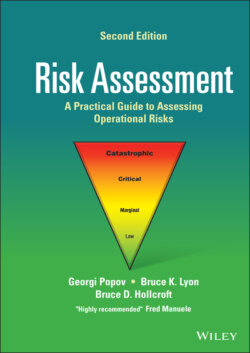Читать книгу Risk Assessment - Georgi Popov - Страница 12
1.1 Introduction
ОглавлениеIn the first edition of this book, the purpose of the first chapter was to encourage safety professionals to recognize the trending throughout the world to include requirements for risk assessments in safety and health‐related standards and guidelines. Further, the position was taken that it was logical to expect that having the capability to make risk assessments would eventually become a requirement for the safety and health position.
To support the positions taken, 35 subjects were included in Addendum A, which was titled “A List of Standards, Guidelines, and Initiatives That Require or Promote Making Risk Assessments – Commencing With the 2005 Year.”
Since that list was prepared, the first international standard for occupational health and safety management systems was adopted by an entity with significant credentials – the International Organization for Standardization (ISO).
This standard, adopted in 2018, is identified as ISO 45001: Occupational health and safety management systems – Requirements with guidance for use. It is commonly referred to as 45001.
In the same year, approval was given to this international standard by the American National Standards Institute (ANSI) to become an American standard. Its designation is ANSI/ASSP/ISO 45001 – 2018, and the secretariat in the United States is the American Society of Safety Professionals (ASSP).
For safety professionals, there is now an international health and safety management systems standard and it requires that risk assessments be made.
Section 6.1.2,2 in 45001 (p. 13) is titled “Assessment of OH&S risks and other risks to the OH&S management system.” Its opening sentence and the beginning of item (a) are as follows:
The organization shall establish, implement, and maintain a process(es) to:
1 “assess OH&S risks from the identified hazards.”
In the previously mentioned Addendum A, item 34 was “ANSI/AIHA Z10‐2012: a standard for Occupational Health and Safety Management Systems.” This standard is now known as Z10. This, the second edition of Z10, also included a provision requiring that risk assessments be made.
A third version of Z10 was approved by the ANSI in August 2019. Since the ASSP is now the secretariat, the name of the standard was changed and is now known as “ANSI/ASSSP Z10.0 – 2019: Occupational Health and Safety Management Systems.”
Section 8.2 in the most recent version of Z10 (p. 17) is titled “Identification of Hazards.” Identification of hazards is necessary, first, in making a risk assessment. Section 8.3 (p. 18) is titled “Risk Assessment.” It requires that an organization establish and implement a risk assessment process(es).
So, for safety professionals, there is also an American National Standard requiring that risk assessment procedures be established as an element within safety and health management systems.
Adoption of 45001 was a momentous development. It has international implications of considerable measure. Safety professionals in the United States should realize that there are two ANSI standards requiring that risk assessments be made and achieve the necessary knowledge and capabilities.
Working with design and operations personnel to assess risks and to give counsel in the decision‐making to achieve acceptable risk levels adds an easily recognized value.
Imaginative safety professionals will recognize this opportunity to be additionally perceived as members of the management team and increase their value to their organizations.
